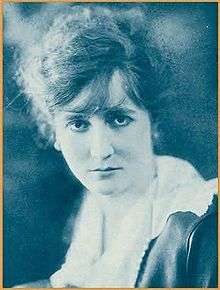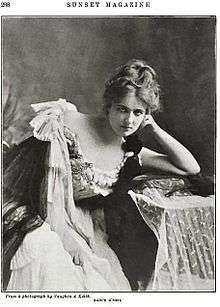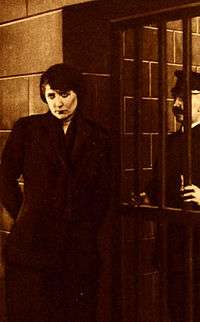Nance O'Neil
- Not to be confused with Australian-born British actress Nancy O'Neil
| Nance O'Neil | |
|---|---|
 | |
| Born |
Gertrude Lamson October 8, 1874 Oakland, California, U.S. |
| Died |
February 7, 1965 (aged 90) Englewood, New Jersey, U.S. |
| Other names | Nancy O'Neil |
| Occupation | Actress |
| Years active | 1902-1932 |
| Spouse(s) | Alfred Hickman (1916-1931; his death) |
Nance O'Neil (aka Nancy O'Neil; October 8, 1874 – February 7, 1965) was an American actress of stage and silent cinema of the early 20th century, dubbed the American Bernhardt.
Early life
O'Neil was born in Oakland, California, as Gertrude Lamson to George Lamson and Arre Findley.[1] When she decided to become an actress, her religious father, an auctioneer, denounced his daughter in church for going on the stage and asked the congregation to pray for her.
Stage roles
A critic in The New York Times wrote of O'Neil's talents in 1908, stressing the positives of her performances while warning of the actress' drawbacks. "There is no actress on the stage at present who has a more remarkable gift for emotional expression, nor is there a single one who has been more lavishly endowed by nature with the physical gifts which enter into the equipment of great actresses", he wrote. "Miss O'Neil has a kind of massive beauty, and she is not without much natural grace. Her voice is a splendid organ, rich and deep, with plenty of color and sweetness. There are moments when it is expressive of deep feeling. But there are more extended periods when it is pitched in monotonous cadences, during which the actress speaks seem to be delivered without a hint of genuine feeling or understanding, when, in short, she is simply an actress giving voice to words that she has conned and learned by rote and delivered in a sort of phonographic manner without a suggestion of the thought behind them".[2]

Early in her acting career, she was managed by McKee Rankin, an actor, manager, and producer who made her a star in Australia and oversaw her London debut in 1902 in the play Magda, in which she was described as "intense, imperious and unequal".[3] (In 1899, Rankin and O'Neil were rumored to have married but the announcement was declared incorrect.) In her role as the title character in the 1906 adaptation of Leah, the Forsaken, she recreated the role made famous by Italian actress Adelaide Ristori. Her performances in Leah (an adaptation of a translation of Salomon Hermann von Mosenthal's Deborah) were described as 'genius' by Fremont Older. She also appeared in Trilby, Camille, The Common Standard, The Wanderer, Macbeth, Agnes, Sappho, The Passion Flower, Hedda Gabler, and many other productions in the United States and Europe.
The statuesque (nearly six-foot) O'Neil performed in Louisville, Kentucky, opposite such actors as Wilton Lackaye, Edmund Breese, William Faversham, Tom Wise and Harriet E. MacGibbon. There were regular productions, including Ned McCobb's Daughter, The Front Page, The Big Fight. A "transcontinental tour" of The Big Fight began in Boston, took in New Haven and Hartford, and ended at Caine's storehouse. She also acted in plays by Shakespeare and Ibsen in Boston in the late 1920s. On November 29, 1922, she was featured at the opening night of the Columbia Theatre in Sharon, Pennsylvania. For a period in the early 1900s O'Neil owned her own acting company, in which Lionel Barrymore came to early public notice.
Hollywood
In Hollywood, she began in silent movies, such as The Kreutzer Sonata (1915). She successfully made the transition to sound films, appearing in movies such as Ladies of Leisure, Royal Bed, and The Rogue Song (all in 1930), Cimarron and Transgression in 1931, and False Faces (1932), which proved to be her final film.
Relationship with Lizzie Borden
In 1904, O'Neil met Lizzie Borden in Boston. The two had a close friendship, which incited considerable gossip-mongering.[4][5]
O'Neil was a character in the musical Lizzie Borden: A Musical Tragedy in Two Axe, where she was played by Suellen Vance. The women's implied romantic relationship was explored in the 2010 play Nance O'Neil by David Foley.[6]
O'Neil was also a character in a play by William Norfolk, The Lights are Warm and Colored. Set in 1905, it uses Lizzie's friendship with O'Neil and other theatrical players as a vehicle for a play within a play. The actors recreate scenes from the murder trial in an improv-like setting, coached or criticized by Lizzie and Emma. The playwright seems to think that Lizzie was innocent, and the real perpetrator was the maid, who makes a surprise visit at the end.[7]
Marriage
In 1916 O'Neil married Alfred Hickman (né Alfred Scott Devereaux-Hickman), a British-born film actor who was previously married to actress Blanche Walsh. He died in 1931. Hickman and O'Neil costarred as Nicholas II of Russia and Empress Alexandra in the silent film, The Fall of the Romanovs (1917).
Death
O'Neil was a resident of the Lillian Booth Actors Home in Englewood, New Jersey, and died there on February 7, 1965, aged 90.[8]
She was buried in Forest Lawn Memorial Park, Glendale, California, in the Columbarium of the Sanctuaries, Niche #10022.[9]
Partial filmography

- The Count of Monte Cristo (1913)
- The Kreutzer Sonata (1915)
- Souls in Bondage (1916)
- The Flames of Johannis (1916)
- The Iron Woman (1916)
- The Fall of the Romanoffs (1917)
- Resurrection (1927)
- His Glorious Night (1929)
- Ladies of Leisure (1930)
- The Rogue Song (1930)
- Call of the Flesh (1930)
- The Royal Bed (1931)
- Cimarron (1931)
- Resurrection (1931)
- Transgression (1931)
- A Woman of Experience (1931)
References
- ↑ GREAT STARS OF THE AMERICAN STAGE" by Daniel Blum c. 1952 Profile #36
- ↑ Nance O'Neil's Acting and What It Represents", The New York Times", 11 October 1908
- ↑ "Nance O'Neil In Magda: American Actress's London Debut: The Papers Critical but Friendly", The New York Times, 2 September 1902
- ↑ "Sisters Estranged Over Nance O'Neill". The San Francisco Call. June 7, 1905. Retrieved June 13, 2008 – via WikiMedia Commons.
- ↑ Adams, Cecil (March 13, 2001). "Did Lizzie Borden kill her parents with an ax because she was discovered having a lesbian affair?". The Straight Dope. Retrieved November 21, 2008.
- ↑ Rooney, David (September 20, 2010). "Lizzie Borden Finds Love (Perhaps) After the Ax". The New York Times.
- ↑ Bay, Sherman (November 24, 2012). "The Lights are Warm and Colored". play.
- ↑ "Nance O'Neil, 90, Tragedienne Of Stage in Early 1900's, Dead". New York Times. February 8, 1965. Retrieved 2015-01-06.
Nance O'Neil, an actress who starred in dozens of tragic roles in the early part of the century, died yesterday in Englewood, N.J. She was 90 years old. ...
- ↑ Nance O'Neil at Findagrave.com.
Further reading
- Johnson Briscoe (1908). The Actors' Birthday Book: 2d Series. An Authoritative Insight Into the Lives of the Men and Women of the Stage Born Between January First and December Thirty-first. Moffat, Yard. p. 229.
- John Herbert Gill – Detecting Gertrude Stein And Other Suspects on the Shadow Side of Modernism (ISBN 0-9727091-0-X)
External links
| Wikimedia Commons has media related to Nance O'Neil. |
- Nance O'Neil at the Internet Movie Database
- Nance O'Neil filmography at the American Film Institute
- Nance O'Neil biography on famousandgay.com
- Nance O'Neil gallery on lizzieandrewborden.com
- How Lizzie Borden Got Away With Murder on http://crimemagazine.com
- Straight Dope staff report by John Corrado
- The Lights are Warm and Colored on YouTube performed by the St. Louis City Players, 1969
- Nance O'Neil at Findagrave.com.
- Nance O'Neil page at Corbis
- Nance O'Neil and Elsie Ferguson in "The House of Women"(1927)
- Nance O'Neil, gallery ; University of Washington, Sayre collection (*upgraded to new url)